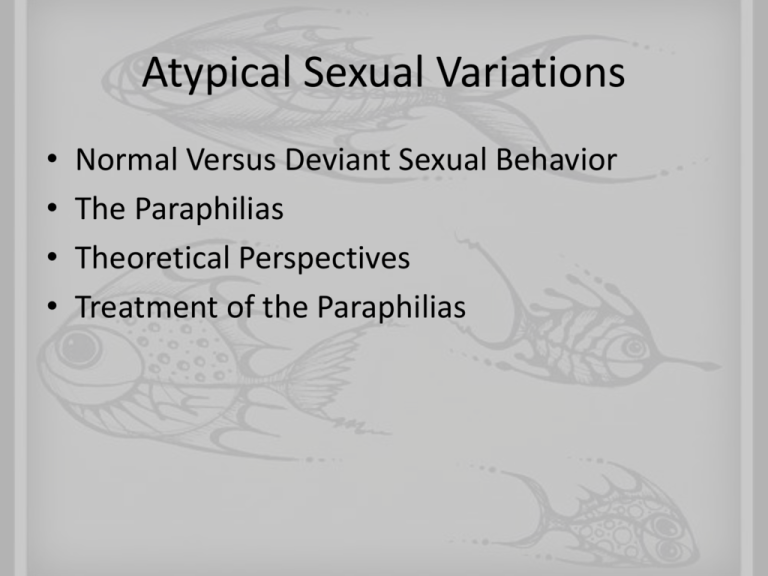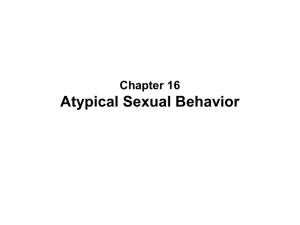
Atypical Sexual Variations
•
•
•
•
Normal Versus Deviant Sexual Behavior
The Paraphilias
Theoretical Perspectives
Treatment of the Paraphilias
Normal Versus Deviant Sexual
Behavior
• Defining Normal Sexual Behavior
– Frequency of the behavior
– Cultural considerations
– Persistent preference for nongenital sexual
outlets
– Atypical variations
• Unusual patterns of arousal or behavior
The Paraphilias
• Paraphilia
– A diagnostic category used by the American Psychiatric
Association
• Used to describe atypical patterns of sexual arousal or
behavior that become problematic to the individual or society
• Urges are recurrent and are either acted on or are distressing
to the individual.
– Milder forms of these behaviors may be practiced by
many people, however.
– Mostly occur among men
– Some are harmless and victimless, while others can
have serious effects on others
The Paraphilias
• Fetishism
– Inanimate object elicits sexual arousal
• Common objects are articles of clothing and materials
made of rubber, leather, silk, or fur.
– Partialism
• Related to fetishism in which sexual arousal is
exaggeratedly associated with a particular body part
– Such as feet, breasts, or buttocks
– Most fetishes and partialisms are harmless.
The Paraphilias
• Transvestism
– Person repeatedly cross-dresses to achieve sexual
arousal or gratification or is troubled by persistent,
recurring urges to cross-dress
– Almost all transvestites are men.
• Both gay and heterosexual males report transvestism.
– It is not the same as transsexualism.
• Transsexuals cross-dress because of discomfort with their
anatomic sex and desire to be the other sex
• However, some transvestites and some transsexuals may be
motivated by autogynephilia
– A fetish in which men are sexually stimulated by fantasies that
their own bodies are female
The Paraphilias
• Exhibitionism
– Urges and fantasies involving exposing one’s genitals to
unsuspecting strangers
• Provides sexual arousal or gratification
• Urges are either acted upon or are disturbing
– Exposure to exhibitionism is common.
• A sample of college women found that one-third had been
approached by a “flasher.”
– Exhibitionists usually are not physically threatening.
• Victims may experience negative psychological consequences.
• Often lonely and sexually repressed
• Some progress to more serious crimes of sexual aggression
The Paraphilias
• Obscene Telephone Calling
– Sexual arousal results from shocking victims
– Telephone scatologia
• A DSM label for a paraphilia characterized by the making of
obscene telephone calls
– Usually socially inadequate heterosexual men
• Voyeurism
– Characterized by observing unsuspecting strangers who are
naked, disrobing, or engaged in sexual relations
– Most, but not all, voyeurs are nonviolent.
– Often feel inadequate and lack social & sexual skills
The Paraphilias
• Sexual Masochism
– Characterized by the desire or need for pain or
humiliation to enhance sexual arousal
– Bondage
• Ritual restraint, as by shackles
– Although some masochists are women, it is much more
common among men.
– Masochists may form relationships with sexual sadists,
people who become sexually aroused by inflicting pain
or humiliation.
The Paraphilias
– Hypoxyphilia
• Person seeks to enhance sexual arousal, usually during
masturbation, by becoming deprived of oxygen
• Sexual Sadism
– Characterized by the desire or need to inflict pain
or humiliation on others to enhance sexual
arousal
The Paraphilias
• Sadomasochism (S&M)
– A mutually gratifying sexual interaction between
consenting sex partners
– Sexual arousal is associated with the infliction and
receipt of pain or humiliation.
– Occasional, mild S&M is common among the
general population.
– S&M subculture exists in the U.S.
– S&M fantasies likely begin in childhood.
The Paraphilias
• Frotteurism
– Characterized by rubbing against or touching a
nonconsenting person
• Often takes place in crowded places such as buses,
subways, or elevators
• Also known as “mashing”
– Reported exclusively among males
• Toucherism
– Related to frotteurism and characterized by the persistent
urge to fondle nonconsenting strangers
The Paraphilias
• Other Paraphilias
– Zoophilia
• Characterized by urges and fantasies involving sexual contact with
animals
• Bestiality
– Involves actual sexual contact with an animal
– Necrophilia
• Characterized by desire for sexual activity with corpses
• 3 types
– Regular: has sex with a dead person
– Necrophilic homicide: person commits murder to obtain corpse for
sexual purposes
– Necrophilic fantasy: person only fantasizes about sex with corpse
• Rare paraphilia & necrophiles are seriously disturbed
The Paraphilias
– Less common paraphilias
• Klismaphilia
– Sexual arousal is derived from the use of enemas
• Coprophilia
– Sexual arousal is attained in connection with feces
• Urophilia
– Sexual arousal is associated with urine
• These paraphilias may have childhood origins.
Theoretical Perspectives
• Biological Perspectives
– Examines factors such as the endocrine system
and the nervous system
• Electroencephalograph (EEG) data show that
paraphilic men’s brains respond differently to sexual
stimuli and paraphilic stimuli compared to control
subjects.
Theoretical Perspectives
• Psychoanalytic Perspectives
– Paraphilias are psychological defenses.
• Usually against unresolved castration anxiety due to the Oedipus
complex
• Suppressed or repressed feelings of sexual guilt and shame
• Learning-Theory Perspectives
– Paraphilias are learned behaviors acquired through
experience.
• An object or situation may be associated with sexual arousal,
fantasies, or orgasm
– Modeling or observational learning also may play a role.
Theoretical Perspectives
• Sociological Perspectives
– Focus on the social context, the effects of the group, and
society in general
• An Integrated Perspective: The “Lovemap”
– Acknowledges the multiple origins of paraphilias
– Money (2000) proposes that childhood experiences create
a lovemap
• A mental representation of the idealized lover and the idealized
erotic activity with the lover
• Lovemaps can become distorted by early traumas.
Treatment of Paraphilias
• Issues in treatment
– Many people with paraphilias don’t want
treatment & don’t seek it voluntarily
– Ethical issues arise when providers are asked to
contribute to judicial processes
– Providers realize they are likely to not be
successful with resistant clients
– Perceived responsibility
Treatment of Paraphilias
• Psychoanalytic Psychotherapy
– Focuses on resolving unconscious conflicts, typically
Oedipal, believed to lead to pathologies such as
paraphilias
• Cognitive-Behavioral Therapy
– Focuses directly on changing behavior
– Systematic desensitization
• A method for terminating the connection between a stimulus
and an inappropriate response
– Relaxation replaces sexual arousal
Treatment of Paraphilias
– Aversion therapy
• A method for terminating undesirable sexual behavior
in which the behavior is paired repeatedly with an
aversive stimulus such as electric shock so that a
conditioned aversion develops
• Covert sensitization
– A form of aversion therapy in which thoughts of engaging in
undesirable behavior are paired repeatedly with imagined
aversive stimuli
» Used with pedophiles, a paraphilia involving sexual
interest in children
Treatment of Paraphilias
– Social skills training
• Behavior therapy methods for building social skills
that rely on a therapist’s coaching and practice
– Used to help individuals relate to the other gender
– Orgasmic reconditioning
• A method for strengthening the connection between
sexual arousal and appropriate sexual stimuli by
repeatedly pairing the desired stimuli with orgasm
Treatment of Paraphilias
• Medical Approaches
– Selective serotonin reuptake inhibitors (SSRIs)
• Used to treat exhibitionism, voyeurism, and fetishism
– May treat the obsessive-compulsive quality of paraphilias
– Anti-androgen drug
• A chemical substance that reduces the sex drive by lowering the
level of testosterone in the bloodstream
– Depo-Provera is used in the treatment of sex offenders
» Suppresses, but does not eliminate, sexual desire in men
• Unlike surgical castration (removal of the testes), the effects of
this treatment can be reversed.








